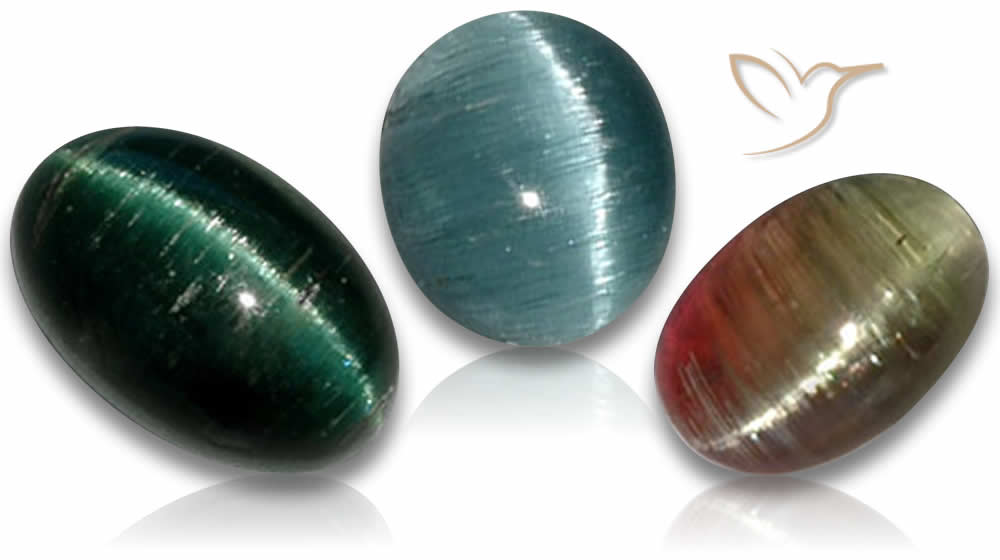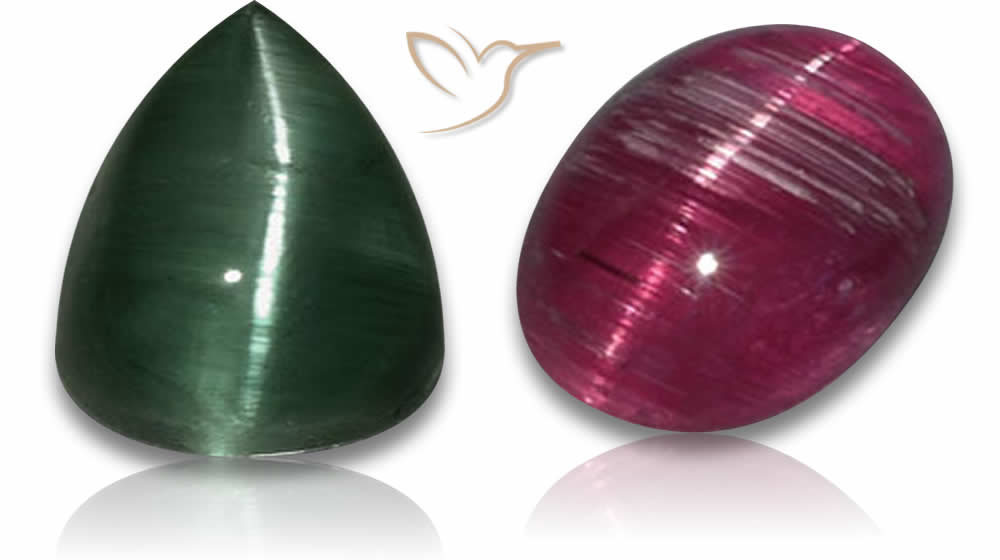Cat's Eye Tourmaline Guide: Colors & Care Tips

Welcome to our Cat's Eye Tourmaline guide! As gemstone enthusiasts, we are excited to share our passion for this rare stone with you. In this guide, we will explore the world of Cat's Eye Tourmaline, from its unique characteristics to its stunning colors and metaphysical properties. Whether you are a collector or new to the gemstone scene, this comprehensive guide will provide you with essential knowledge to appreciate the enchantment of Cat's Eye Tourmaline.
Key Takeaways:
- Cat's Eye Tourmaline is a captivating and sought-after gemstone for jewelry
- It possesses unique characteristics that give it a striking cat's eye effect
- Each color of Cat's Eye Tourmaline holds its own significance and symbolic meaning
- It is cherished by many for its metaphysical properties, including enhancing intuition and promoting strength
- Proper care is essential for maintaining the natural beauty of Cat's Eye Tourmaline jewelry
See our current stock of Cat's Eye Tourmaline here.
What is Cat's Eye Tourmaline?
If you're new to the world of gemstones, you may be wondering: what exactly is Cat's Eye Tourmaline? Well, to put it simply, it's a fascinating type of tourmaline that exhibits a unique visual effect known as chatoyancy. This effect is caused by microscopic, parallel inclusions of rutile, which create a narrow band of light that appears to move across the surface of the gemstone. The result? A mesmerizing "cat's eye" effect that is highly coveted by gemstone collectors and jewelry enthusiasts alike.
But what really sets Cat's Eye Tourmaline apart is the fact that it can be found in an array of stunning colors, from rich greens and pinks to vivid blues and yellows. Whether you're looking for a statement piece or a subtle accent, there is a shade of Cat's Eye Tourmaline to suit every taste.
In general, Cat's Eye Tourmaline is considered a rare and highly prized gemstone. While it may not be as well-known as diamonds or rubies, it is valued for its unique beauty and captivating optical properties.
Colors and Meanings of Cat's Eye Tourmaline
Cat's Eye Tourmaline comes in a wide range of colors, each with its own unique symbolism and energy. Understanding the significance of each hue can help you choose the perfect stone to match your needs and desires.
Green Cat's Eye Tourmaline
Green Cat's Eye Tourmaline is a powerful stone of healing and growth. It's associated with the heart chakra and is said to promote self-discovery, emotional balance, and compassion. Wear green cat's eye tourmaline to stimulate creativity and renew your focus on personal and professional goals.
Blue Cat's Eye Tourmaline
Blue Cat's Eye Tourmaline is a stone of communication and truth. Its tranquil hues are believed to calm the mind and ease anxiety, making it a perfect choice for public speakers and performers. Blue cat's eye tourmaline is also thought to enhance intuition and provide protection against negative energy.
Brown Cat's Eye Tourmaline
Brown Cat's Eye Tourmaline is a grounding stone, perfect for those who seek stability and balance. It's associated with the root chakra and is believed to help alleviate stress, fear, and feelings of isolation. Wear brown cat's eye tourmaline to boost self-confidence and ward off negativity.
Pink Cat's Eye Tourmaline
Pink Cat's Eye Tourmaline is a stone of love and emotional healing. It's believed to open the heart chakra and facilitate forgiveness and understanding in relationships. Wear pink cat's eye tourmaline to attract love and strengthen existing connections.

Black Cat's Eye Tourmaline
Black Cat's Eye Tourmaline is a protective stone, known for its ability to absorb negative energy and promote a sense of safety and security. It's associated with the root chakra and is believed to help overcome fears and phobias. Wear black cat's eye tourmaline to boost self-awareness and protect against psychic attacks.
In summary, the colors of Cat's Eye Tourmaline hold deep spiritual and emotional meanings that can guide us through life's challenges and opportunities. Whether you're seeking healing, love, protection, or creativity, there's a cat's eye tourmaline for every need.
Properties and Benefits of Cat's Eye Tourmaline
Cat's Eye Tourmaline is not only a beautiful gemstone, but it also offers a range of metaphysical properties and benefits.
Metaphysical Properties
Known for its ability to stimulate intuition and perception, Cat's Eye Tourmaline is a powerful gemstone for those seeking to enhance their spiritual awareness. It is said to provide protection against negativity, absorb electromagnetic radiation, and increase physical vitality and endurance. Additionally, this gemstone is thought to promote mental clarity, increase self-confidence, and encourage emotional stability.
Healing Properties
Cat's Eye Tourmaline is often associated with physical healing properties, including its ability to alleviate eye strain and improve vision. It is also believed to strengthen the immune system, reduce inflammation, and soothe digestive issues. This gemstone is also said to help in overcoming addiction and break unhealthy habits.
Benefits for Relationships
When it comes to romantic relationships, Cat's Eye Tourmaline can offer a range of benefits. This gemstone is said to promote communication, enhance empathy and compassion, and encourage forgiveness. It is thought to provide support during times of emotional turmoil, strengthen the bond between partners, and create a sense of harmony and balance in the relationship.
Overall, Cat's Eye Tourmaline is a versatile and powerful gemstone that offers a wide range of benefits for the mind, body, and soul. Whether you're looking to enhance your intuition, protect against negativity, or improve your relationships, this gemstone is a wonderful addition to any collection.
Caring for Your Natural Cat's Eye Tourmaline Jewelry
Cat's Eye Tourmaline is a stunning gemstone that deserves to be lovingly cared for to maintain its natural beauty. Here are some tips to ensure that your Cat's Eye Tourmaline jewelry stays in pristine condition over time:
Cleaning Your Cat's Eye Tourmaline Jewelry
Clean your Cat's Eye Tourmaline jewelry using warm water and a mild soap, such as dish soap. Use a soft-bristled brush to gently scrub the gemstone and remove any dirt or grime. Rinse the jewelry thoroughly and dry it with a soft cloth before storing it.
Avoid exposing your Cat's Eye Tourmaline jewelry to harsh chemicals, such as bleach or ammonia, as this may damage the gemstone and cause it to lose its natural beauty.
Protecting Your Cat's Eye Tourmaline Jewelry
Store your Cat's Eye Tourmaline jewelry in a separate compartment or pouch away from other jewelry to avoid scratches and damage. Additionally, remove your jewelry before engaging in any strenuous activity or household chores that may cause damage.
Professional Cleaning and Maintenance
Take your Cat's Eye Tourmaline jewelry to a professional jeweler for cleaning and maintenance once a year. They will inspect the jewelry for any damage and make any necessary repairs to keep your jewelry looking its best.
By following these essential care tips, your Natural Cat's Eye Tourmaline jewelry will stay in pristine condition for years to come and continue to be a cherished addition to your collection.
Conclusion
As we conclude our Cat's Eye Tourmaline guide, we hope you have gained valuable insights into this enchanting gemstone. From its mesmerizing colors and unique characteristics to its metaphysical properties and benefits, Cat's Eye Tourmaline has something to offer for everyone.
When it comes to healing properties, Cat's Eye Tourmaline is believed to enhance intuition and promote strength and protection. It is also considered to be an excellent stone for grounding and balancing energy. As for the price, it varies depending on the color, size, and quality of the gemstone.
Many people prefer to incorporate Cat's Eye Tourmaline into their jewelry. A Cat's Eye Tourmaline necklace, for instance, can add a touch of sophistication and elegance to any outfit. However, it is crucial to take care of your natural Cat's Eye Tourmaline jewelry to maintain its luster and shine.
In a nutshell, Cat's Eye Tourmaline is a beautiful gemstone that offers more than just aesthetic value. Its colors, meanings, properties, and benefits make it a popular choice for those who seek to embrace its mystical allure.
FAQ
What is Cat's Eye Tourmaline?
Cat's Eye Tourmaline is a unique gemstone that exhibits a captivating cat's eye effect. This effect is caused by a phenomenon known as chatoyancy, where a band of light appears to move across the surface of the gemstone, resembling the slit eye of a cat.
What are the colors and meanings of Cat's Eye Tourmaline?
Cat's Eye Tourmaline comes in a range of colors, including green, blue, yellow, and brown. Each color holds its own symbolic meaning. For example, green is associated with growth and abundance, while blue represents calmness and intuition.
What are the properties and benefits of Cat's Eye Tourmaline?
Cat's Eye Tourmaline is said to possess several metaphysical properties, including enhancing intuition, promoting protection, and stimulating creativity. It is also believed to bring good luck and ward off negative energies.
How should I care for my Cat's Eye Tourmaline jewelry?
To keep your Cat's Eye Tourmaline jewelry looking its best, it is recommended to avoid exposing it to harsh chemicals or extreme temperatures. Regular cleaning with a soft cloth and mild soap will help maintain its luster. Additionally, store your jewelry separately to prevent scratches and damage.

